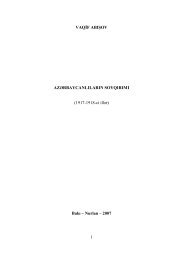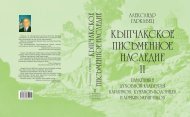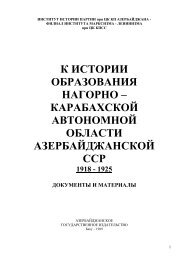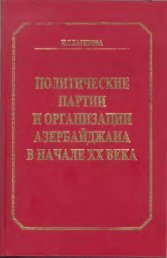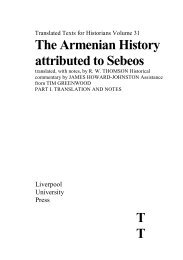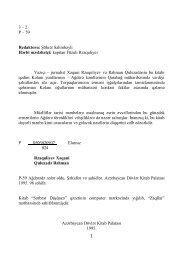ARMENIAN - Erevangala500
ARMENIAN - Erevangala500
ARMENIAN - Erevangala500
Create successful ePaper yourself
Turn your PDF publications into a flip-book with our unique Google optimized e-Paper software.
The Armenian Orthodox patriarch of Istanbul ruled over<br />
all Christians who did not belong to the Greek Orthodox<br />
Church. Aside from the Armenian Gregorians themselves,<br />
these included the Monophysitic churches o f Asia<br />
Minor and Africa, such as the Jacobites and the Syrians,<br />
as well as the Copts in Egypt.<br />
In those days, gypsies were believed to come from Egypt<br />
and were called "Copti". Therefore, all the gypsies of the<br />
Ottoman Empire were also subject to the rule of the Armenian<br />
patriarch of Istanbul in matters of civil law.<br />
Another religious group under Armenian Orthodox rule<br />
were the Bogomils of the Balkans and their founding<br />
fathers, the Paulicians. They still survived in small communities<br />
in eastern Anatolia and held Manichean beliefs.<br />
The history of the historical province of Armenia and the<br />
many peoples who have lived there begins under the banner<br />
o f the fight between East and West for world supremacy.<br />
The Haik, an Indo-European people, probably from the<br />
Balkans or Thrace, migrated to the historical province of<br />
Armenia in the sixth century B.C. At that time, the Urartian<br />
kingdom was collapsing under the blows of the<br />
Scythians.<br />
The newly-arrived Indo-European Haik mixed with the<br />
Urartians to some extent. The Asian language of the Urartians<br />
was an agglutinative language like Turkish. It had a<br />
certain influence on the Indo-European language of the<br />
Armenians, as did the superior culture of the Urartians.<br />
While their immigration to eastern Anatolia was still going<br />
on, the Haik (Armenians) fell under Median rule, and<br />
in the year 550 the emperor Kyros took possession of the<br />
ancient lands of the Urartians along with the newly arrived<br />
Haik. The first mention of the Armenians is to be<br />
found in the inscription of Behistun in connection with<br />
the triumphant reports of the victories of Darius (486<br />
B.C.) At that time, the Armenians were already Persian<br />
subjects.<br />
In the fourth century before Christ, Armenia (with all its<br />
races, tribes, and people of mixed blood) was under the<br />
rule of the Achaemids and later, that o f the Seleucids.<br />
When the Parthians took over, the Armenian prince Ti-<br />
granes became a hostage in the Parthian court. Tigranes<br />
II. (95-55 B.C.) succeeded in freeing Armenia from the<br />
Parthians and creating an independent Annenian nation.<br />
His capital was Tigranakert (now called Silvan, southwest<br />
of Lake Van). Tigranes II. married the daughter of<br />
the king o f Pontus, Mithridates VI. Eupator, and made the<br />
disastrous mistake of joining Mithridates in a revolt<br />
against Rome.<br />
In 69 B.C., the Roman general Lucullus defeated the Armenian<br />
ruler Tigranes II., and the short-lived dream of<br />
Armenian independence was over. For the Haik to refer<br />
nowadays on occasion to that short period of real Armenian<br />
rule in eastern Anatolia and for Armenian terrorists<br />
to base their territorial demands on that is comparable to<br />
Italian mafiosi in the United States wishing to be the sue-<br />
32<br />
When the Armenian king Tigranes refused to hand over his<br />
megalomaniac father-in-law, Mithridates, ruler of Pontos, to<br />
the Roman generals, Lucullus attacked "Tigranes City".<br />
Tigranes' armored lancers were alone more numerous than<br />
Lucullus' entire force, which the Armenians scorned, saying it<br />
was "too large for a legation but too small for an army". The<br />
battle lasted just one day (October 9, 69 A. D.), and the Romans<br />
destroyed the army o f Tigranes, which had been twenty times<br />
stronger. According to the Roman military report there were<br />
virtually no Romans killed at all, only Armenians. Tigranes<br />
managed to escape unrecognized and met up again with his<br />
father-in-law, Mithridates, who was later killed by his own peo-<br />
le. The subject peoples deserted the tyrant Tigranes and paid<br />
omage to the victors, Lucullus and Pompeius.<br />
cessors of the Romans (or better of Lucullus or Trajan)<br />
and taking control of eastern Anatolia as the heirs of the<br />
victors o f Tigranakert . . . The French could demand vast<br />
portions of North America over which they once ruled.<br />
And the examples go on ad infinitum. If every group of<br />
people claimed all the lands over which they ruled at<br />
some point in their history, then the entire world would<br />
have to be evacuated and resettled, and there would be<br />
constant warfare.<br />
There were several eventful centuries during which dominance<br />
in eastern Anatolia belonged sometimes to the<br />
Romans (Trajan, Nero, Hadrian, Diocletian) and sometimes<br />
to the Persian Sassanids. At the end o f this period,<br />
the emperor Diocletian named Tiridates III. King of<br />
Armenia. Gregory Parthev, a Parthian, preached<br />
Christianity. The most recent findings indicate that<br />
Armenia did not adopt Christianity until after the conversion<br />
o f the emperor Constantine in 313 A.D. The<br />
Armenian conversion most likely occured in 314 at the<br />
behest of King Trdat (Tiridates). The missionizing of<br />
Armenia probably began in Edessa (present-day Urfa). It<br />
has been proven that Christian communities existed as<br />
early as the second century. The great converter was<br />
Gregory Parthev Lusarevic, the Illuminator. He was not a<br />
Haik, but rather an Armenian in the true sense of the<br />
word, an inhabitant o f the province of Armenia. He was,<br />
however, of Parthian origin.<br />
Gregory lived in Roman Caesarea (Kayseri) as a refugee<br />
from the Persians. It was there that he became a<br />
Christian. At first, King Tiridates persecuted Gregory,<br />
but then he himself became a Christian, and with him,<br />
gradually, the people of Armenia.<br />
Christianity quickly took hold throughout the Roman Empire,<br />
in Georgia as well as in Caucasian Albania and in<br />
Armenia. This deeply troubled the Persians. Julian the<br />
Apostate, who might have been able to handle the Persians,<br />
died unexpectedly. His successor, Jovian, relinquished<br />
the Caucasus and Armenia to the Persians without<br />
a fight. After the death of Emperor Theodosius in 395, the



